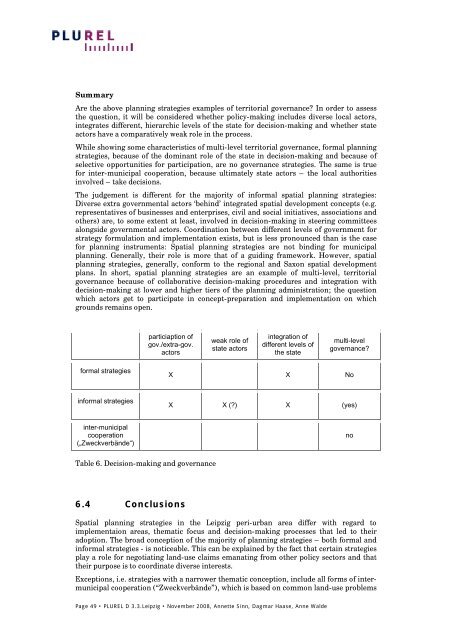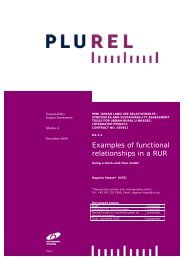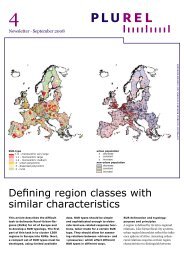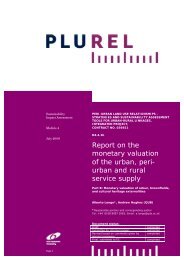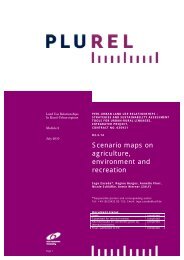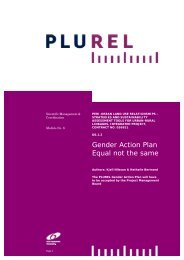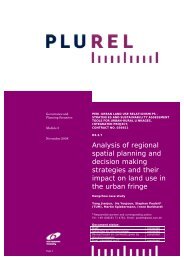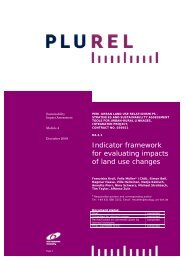Analysis of regional spatial planning and decision making ... - Plurel
Analysis of regional spatial planning and decision making ... - Plurel
Analysis of regional spatial planning and decision making ... - Plurel
Create successful ePaper yourself
Turn your PDF publications into a flip-book with our unique Google optimized e-Paper software.
Summary<br />
Are the above <strong>planning</strong> strategies examples <strong>of</strong> territorial governance In order to assess<br />
the question, it will be considered whether policy-<strong>making</strong> includes diverse local actors,<br />
integrates different, hierarchic levels <strong>of</strong> the state for <strong>decision</strong>-<strong>making</strong> <strong>and</strong> whether state<br />
actors have a comparatively weak role in the process.<br />
While showing some characteristics <strong>of</strong> multi-level territorial governance, formal <strong>planning</strong><br />
strategies, because <strong>of</strong> the dominant role <strong>of</strong> the state in <strong>decision</strong>-<strong>making</strong> <strong>and</strong> because <strong>of</strong><br />
selective opportunities for participation, are no governance strategies. The same is true<br />
for inter-municipal cooperation, because ultimately state actors – the local authorities<br />
involved – take <strong>decision</strong>s.<br />
The judgement is different for the majority <strong>of</strong> informal <strong>spatial</strong> <strong>planning</strong> strategies:<br />
Diverse extra governmental actors ‘behind’ integrated <strong>spatial</strong> development concepts (e.g.<br />
representatives <strong>of</strong> businesses <strong>and</strong> enterprises, civil <strong>and</strong> social initiatives, associations <strong>and</strong><br />
others) are, to some extent at least, involved in <strong>decision</strong>-<strong>making</strong> in steering committees<br />
alongside governmental actors. Coordination between different levels <strong>of</strong> government for<br />
strategy formulation <strong>and</strong> implementation exists, but is less pronounced than is the case<br />
for <strong>planning</strong> instruments: Spatial <strong>planning</strong> strategies are not binding for municipal<br />
<strong>planning</strong>. Generally, their role is more that <strong>of</strong> a guiding framework. However, <strong>spatial</strong><br />
<strong>planning</strong> strategies, generally, conform to the <strong>regional</strong> <strong>and</strong> Saxon <strong>spatial</strong> development<br />
plans. In short, <strong>spatial</strong> <strong>planning</strong> strategies are an example <strong>of</strong> multi-level, territorial<br />
governance because <strong>of</strong> collaborative <strong>decision</strong>-<strong>making</strong> procedures <strong>and</strong> integration with<br />
<strong>decision</strong>-<strong>making</strong> at lower <strong>and</strong> higher tiers <strong>of</strong> the <strong>planning</strong> administration; the question<br />
which actors get to participate in concept-preparation <strong>and</strong> implementation on which<br />
grounds remains open.<br />
particiaption <strong>of</strong><br />
gov./extra-gov.<br />
actors<br />
weak role <strong>of</strong><br />
state actors<br />
integration <strong>of</strong><br />
different levels <strong>of</strong><br />
the state<br />
multi-level<br />
governance<br />
formal strategies<br />
X X No<br />
informal strategies<br />
X X () X (yes)<br />
inter-municipal<br />
cooperation<br />
(„Zweckverbände“)<br />
no<br />
Table 6. Decision-<strong>making</strong> <strong>and</strong> governance<br />
6.4 Conclusions<br />
Spatial <strong>planning</strong> strategies in the Leipzig peri-urban area differ with regard to<br />
implementaion areas, thematic focus <strong>and</strong> <strong>decision</strong>-<strong>making</strong> processes that led to their<br />
adoption. The broad conception <strong>of</strong> the majority <strong>of</strong> <strong>planning</strong> strategies – both formal <strong>and</strong><br />
informal strategies - is noticeable. This can be explained by the fact that certain strategies<br />
play a role for negotiating l<strong>and</strong>-use claims emanating from other policy sectors <strong>and</strong> that<br />
their purpose is to coordinate diverse interests.<br />
Exceptions, i.e. strategies with a narrower thematic conception, include all forms <strong>of</strong> intermunicipal<br />
cooperation (“Zweckverbände”), which is based on common l<strong>and</strong>-use problems<br />
Page 49 • PLUREL D 3.3.Leipzig • November 2008, Annette Sinn, Dagmar Haase, Anne Walde


